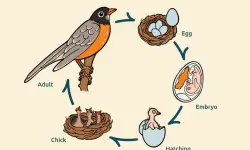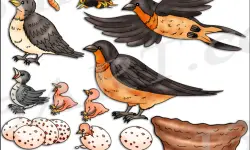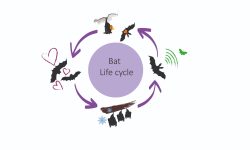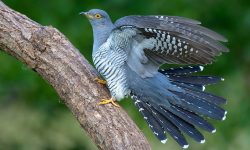South Carolina’s mix of coastal plains, dense forests, and river valleys provides an ideal home for a wide range of raptors. Hawks, in particular, are well represented across the Palmetto State. Whether you’re watching the skies over Congaree National Park or scanning the trees near the Blue Ridge foothills, you’re likely to spot one of these sharp-eyed predators. This guide introduces you to eight hawk species you can find in South Carolina, complete with behavior insights, habitat tips, and feeding habits—plus visuals to help you identify them in the wild.
1. Red-tailed Hawk (Buteo jamaicensis)
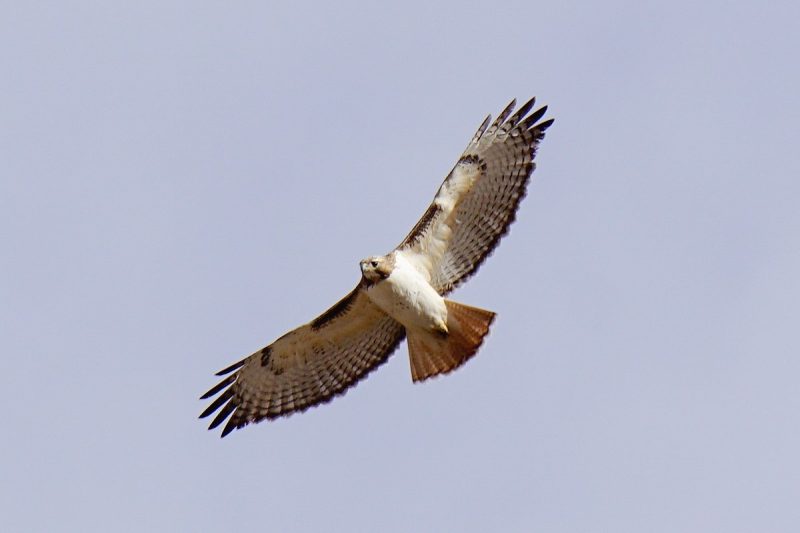
The Broad-Winged Sentinel of South Carolina Skies
With its rich, brick-red tail flashing in the sun and its wide, rounded wings catching every thermal, the Red-tailed Hawk is an unmistakable presence in South Carolina’s skies. This majestic raptor is not only the most widespread hawk in the state, but also one of the most adaptable, thriving from rural farmlands to suburban edges.
These hawks are powerful flyers. Watch as they spiral lazily high above open fields, using rising warm air currents to conserve energy while scanning the ground for prey. Their haunting, raspy scream—famous from countless movie soundtracks—is often heard before they’re seen.
Red-tailed Hawks live in South Carolina year-round. They’re especially easy to spot in winter, when bare branches reveal their bulky silhouettes. Look for them perched on telephone poles, highway signs, fence posts, or tall trees—anywhere with a clear view of open ground. Their broad habitat range includes farmlands, pastures, grasslands, pinewoods, and even busy roadways.
When it comes to hunting, the Red-tailed Hawk is an opportunist with a preference for small mammals. They feed primarily on mice, voles, squirrels, and rabbits, but will also snatch up snakes, lizards, or birds when the opportunity arises. Their strategy is simple yet effective: wait patiently from a high perch, then dive fast and hard when prey moves below. In open fields, they may soar low in circles before making a sudden drop with talons outstretched.
The Red-tailed Hawk is not just a bird of prey—it’s a symbol of the wild spaces that still exist in South Carolina. With their sharp eyes and steady wings, they stand guard over the state’s fields, forests, and highways like true sentinels of the sky.
2.Cooper’s Hawk (Accipiter cooperii)
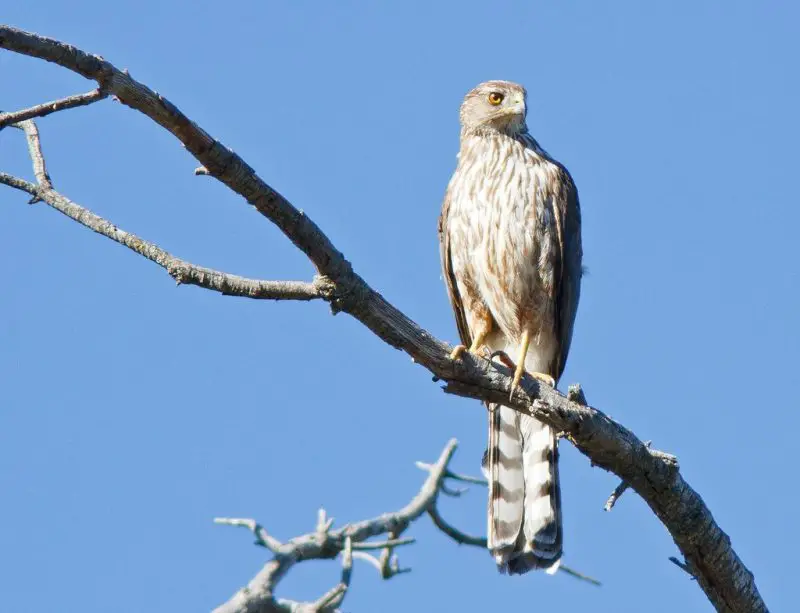
The Suburban Songbird Stalker
With piercing red eyes and a long, banded tail, the Cooper’s Hawk is the epitome of stealth and speed in the avian world. This agile raptor is built for pursuit, slicing through dense trees and shrubs like a guided missile. Its broad chest, short rounded wings, and long rudder-like tail form the perfect toolkit for high-speed chases through cluttered woodland or residential yards.
Unlike most birds seen around feeders, the Cooper’s Hawk isn’t drawn by sunflower seeds—it’s after the visitors. This cunning predator lurks near backyard bird feeders, city parks, and suburban tree lines, waiting for a moment of chaos when it can explode into flight and grab an unsuspecting dove, sparrow, or starling in mid-air.
Though found throughout South Carolina year-round, they’re especially noticeable in the winter months. As migrating flocks of songbirds flood the state, Cooper’s Hawks follow closely, turning the seasonal abundance into a hunting bonanza. While their primary prey is avian, they’re not above snatching a small mammal like a chipmunk or mouse when the opportunity arises.
Whether weaving between trunks in a silent ambush or perched motionless near a brush pile, the Cooper’s Hawk brings a touch of the wild hunt into even the most peaceful backyard.
3. Sharp-shinned Hawk (Accipiter striatus)
The Feathered Flash
Don’t let its petite size fool you—the Sharp-shinned Hawk is a lightning-fast aerial predator with razor-sharp reflexes and a taste for smaller birds. As South Carolina’s tiniest hawk, it’s no less deadly than its larger cousins. Its slim frame, short rounded wings, and long square-tipped tail are perfectly engineered for weaving through tangled branches at breakneck speed.
This hawk strikes like a ghost, appearing out of nowhere in a blur of feathers. It favors surprise attacks, bursting from forest edges or thickets to snatch finches, warblers, and other songbirds mid-flight. With talons extended and wings slicing through the air, its ambush leaves little time for prey to react.
Though Sharp-shinned Hawks don’t typically breed in South Carolina, they’re frequent visitors during migration and throughout the winter. During these cooler months, they patrol wooded neighborhoods, forested parks, and backyard feeders—anywhere small birds congregate. Their presence often sends flocks into frantic flight, a sure sign that a predator is near.
What they lack in size, they make up for in precision and tenacity. Quick, quiet, and cunning, the Sharp-shinned Hawk is a master of ambush, a silent hunter threading its way through the trees like a feathered bullet.
4. Red-shouldered Hawk (Buteo lineatus)
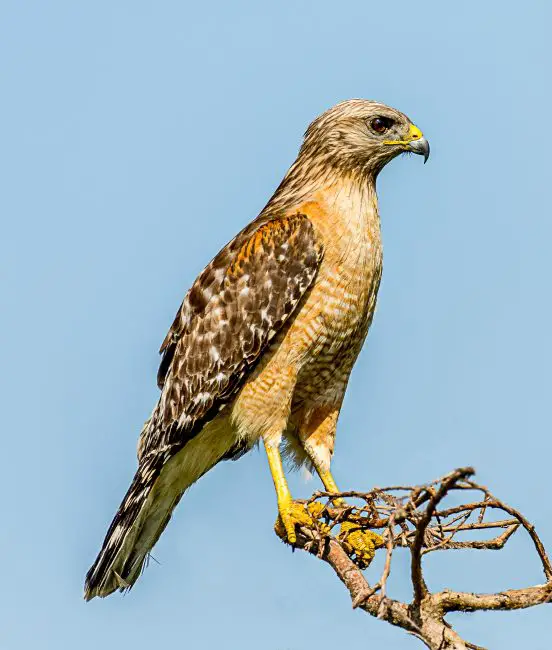
The Swamp Sentinel
Bold, beautiful, and unmistakably loud, the Red-shouldered Hawk reigns over the watery forests of South Carolina with flair. Its rich reddish chest, black-and-white checkered wings, and distinct, high-pitched “kee-yer” cry make it one of the easiest raptors to recognize—often heard echoing through swampy woods long before it’s seen.
This hawk is especially fond of riparian forests, bottomland hardwood swamps, and forested wetlands throughout the Coastal Plain and Piedmont. It’s also surprisingly tolerant of human presence, frequently nesting in wooded suburban neighborhoods as long as water is nearby.
A true wetland predator, the Red-shouldered Hawk has a varied palate. Frogs croaking in the shallows, snakes slipping through the grass, scurrying mice, and large insects are all on the menu. With keen eyesight and powerful talons, it watches patiently from low branches, launching swift attacks on anything that moves below.
More than just a hunter, this hawk plays a vital role in wetland ecosystems, keeping amphibian and rodent populations in check. Its presence is a sign of a healthy, thriving forest—and a reminder that even in the stillness of the swamp, a sentinel is always watching from above.
5. Broad-winged Hawk (Buteo platypterus)
The Migrant in the Sky
Each year, like clockwork, the Broad-winged Hawk graces South Carolina’s skies with one of the most breathtaking avian spectacles—migrating in swirling flocks known as “kettles.” Though this hawk is a quiet presence during breeding season farther north, it becomes a sky-dancing marvel during spring and fall as it passes through the state in great numbers.
With its compact body, broad wings, and bold black-and-white tail bands, the Broad-winged Hawk is built for endurance migration. Thousands may travel together, riding warm thermals in great spiraling columns, especially along mountain ridges and forested ridgetops in the Upstate. For birdwatchers, witnessing a kettle of Broad-winged Hawks is a thrilling highlight of the season.
While in the region, these hawks tend to stick to densely wooded areas, where they perch quietly beneath the canopy, scanning for prey. Their diet is as varied as their travels, including small mammals like voles, reptiles such as lizards and snakes, amphibians like frogs, and even large insects like grasshoppers.
Though they don’t linger long in South Carolina, the Broad-winged Hawk leaves a strong impression—silent forest hunters on the ground, but grand aerial performers in the sky.
6. Northern Harrier (Circus hudsonius)
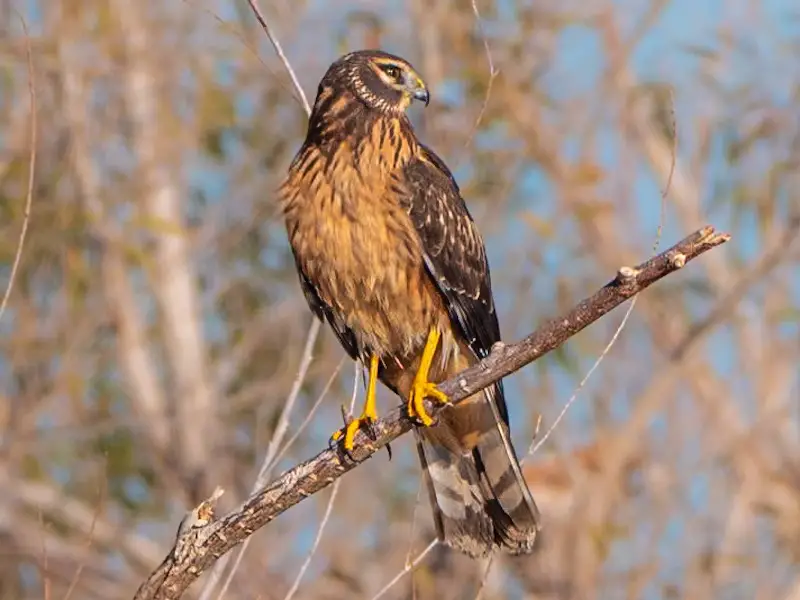
The Low-Flying Glider
Slipping just above the grass tops like a shadow on wings, the Northern Harrier is a hunter of elegance and precision. With its long, slender tail, distinct white rump patch, and ghostly, owl-like facial disc, this raptor is unmistakable as it glides low over open country in a graceful, buoyant flight. Its wings form a shallow V-shape, giving it a unique silhouette compared to other hawks.
Unlike most hawks that soar high or perch to ambush, the Northern Harrier prefers to stay low—hugging the contours of marshes, coastal fields, and wet meadows as it silently scans for movement below. It’s a winter visitor in South Carolina, most commonly seen along the coast and in wide-open landscapes where the grass rustles with potential prey.
This raptor has a rare advantage among hawks: its owl-like facial disc. This adaptation funnels sound to its ears, allowing it to hunt not just by sight, but by sound. Voles, mice, small birds, and even frogs don’t stand much of a chance once the harrier locks in on them. Swooping suddenly, it snatches its quarry from the ground with speed and accuracy.
Part ghost, part predator, the Northern Harrier is a silent sentinel of winter wetlands—gliding effortlessly through the cold air, listening to the earth breathe beneath it.
7. Swainson’s Hawk (Buteo swainsoni)
A Rare and Striking Visitor
Graceful, long-winged, and uncommon, the Swainson’s Hawk is a thrilling find for South Carolina birders lucky enough to spot one. With its long pointed wings, narrow silhouette, and pale underside, it often fools observers into thinking it’s a gull—until a closer look reveals the elegant predator riding the thermals high above.
Though this species is more common in the western half of North America, it occasionally passes through South Carolina during migration. Late spring and early fall are the best chances to catch a glimpse, usually over open fields, grasslands, or ridgetops where thermals help them soar for hours with minimal effort.
Swainson’s Hawks are versatile eaters. During the breeding season in their western habitats, they focus on small mammals and reptiles like mice, ground squirrels, and snakes. But once migration begins, they shift dramatically to a diet dominated by insects—especially grasshoppers and dragonflies. In fact, vast flocks have been recorded feeding on insect swarms during their 6,000-mile journey to and from South America.
Though rare in South Carolina skies, the Swainson’s Hawk stands out with its long-distance stamina, seasonal diet shift, and refined flight style—a striking reminder of the epic scale of bird migration.
8. Osprey (Pandion haliaetus) – Honorable Mention
The Master Fisher
Sleek, powerful, and built for the hunt, the Osprey rules the waterways of South Carolina with unmatched precision. Though not technically a true hawk, this fish-eating raptor shares many similarities—sharp talons, a hooked beak, and a commanding presence in the sky. It’s often included among hawk species due to its size, silhouette, and hunting prowess.
You’ll find Ospreys wherever water meets wilderness. From the winding Savannah River to the vast expanse of Lake Marion, and along Charleston’s tidal creeks and barrier islands, these raptors are a familiar sight in spring and summer. They soar above the water with wings held in a distinct “M” shape, scanning the surface for signs of life below.
When the moment is right, the Osprey plunges feet-first into the water in a spectacular dive—talons extended, eyes locked, and wings flaring just before impact. Their sharp, curved claws and rough footpads help them grasp slippery fish, often carrying their catch headfirst in flight to reduce wind resistance.
With a diet made almost entirely of live fish, the Osprey is a specialist among raptors—a master angler adapted to both freshwater lakes and coastal estuaries. Watching one dive and rise with a wriggling fish in its grip is one of South Carolina’s most iconic wildlife moments, a true testament to nature’s precision engineering.
Final Thoughts
From the dense cypress swamps to the sandy shores and rolling uplands, South Carolina offers a rich environment for hawk-watching. Whether you’re admiring the soaring silhouette of a Red-tailed Hawk or watching a Cooper’s Hawk dart between backyard trees, each sighting reveals the beauty and power of these incredible raptors. So grab your binoculars, head out to the nearest field or forest, and keep your eyes on the sky—South Carolina’s hawks are never too far away.

